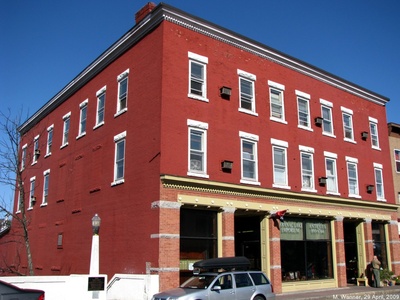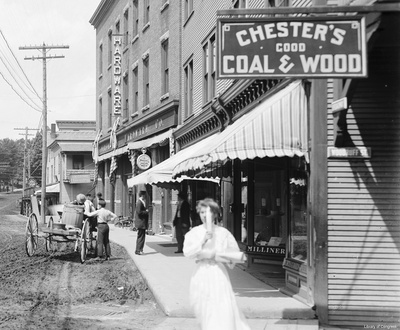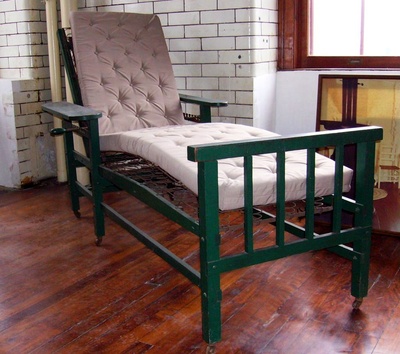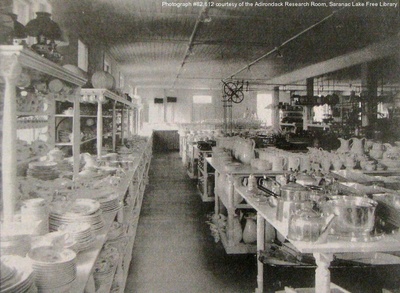 Starks Hardware
Starks Hardware  Broadway, 1909: Dr. Morse, Dentist; J.W. Cromie, Harness Shop; Adirondack Hardware Company; and the Burt and Goodspeed Millinery Shop Address: 28 Broadway
Broadway, 1909: Dr. Morse, Dentist; J.W. Cromie, Harness Shop; Adirondack Hardware Company; and the Burt and Goodspeed Millinery Shop Address: 28 Broadway
Old Address: 29 Broadway
Other names: Adirondack Hardware Company, Aubuchon Hardware, Saranac Lake Emporium; Upscale Resale (antiques)
Year built: 1898; alterations 1975
In April, 1895, George L. Starks, Michael J. Callanan, and William A. Walton made a purchase that signaled the beginning of what would be a Saranac Lake institution for some 65 years. The three men paid R. Eugene Woodruff $5,000 for a prime lot on the east side of Broadway along the right bank of the Saranac River and with a wide right-of-way to Woodruff Street. What they started was the Adirondack Hardware Co. The building they built is the largest commercial structure in the District and one that, more than any other, conveys a sense of strength and solidity carried quietly. The Adirondack Hardware Co., building and store, opened for business by 1898.
William Walton bowed out of the organization in June of 1900 and, with H.H. Tousley, started the village's other major, pre-WWI hardware company, Walton and Tousley Hardware.
Callanan provided much of the capital needed to get Adirondack Hardware started. He was from Keeseville and a brother of William Callanan who, with Augustine Branch, founded Saranac Lake's most famous construction company. Callanan’s sister, Agnes, married George Starks on July 9, 1909.
Starks himself was born and raised in Peru, New York, a few miles north of Keeseville, and he had been a school teacher before getting into the hardware business. He was a proud man who some people did not like, but who nearly all respected. He demanded the best his employees could give. He wasn't the highest paying boss in town by any means, and his workers worked hard for what they got; but he was "square" enough with them to command their loyalty. In fact, he demanded the best in everything — and he usually got it.
He also had a way of getting the most from what was already his — such as with his lot at 29 Broadway. His north line was not at the river's south shore but down the river's middle. So he felt no compunction about using every inch of dry land for his building, in fact, the foundation walls are flush with the original shoreline (the "new", made-by-Starks shoreline is 3 1/2 feet farther north). Because of this, the building's footings in some places go down as far as 93 feet.
 Adirondack Recliner, Historic Saranac Lake collection In April, 1903, Adirondack Hardware acquired the "Berkeley Barn Lot" on Woodruff Street and adjoining the hardware's original property. In the early days it behooved a hotel to be as self-sufficient as possible. Most of the larger or longer established hotels in the region had at least a big garden and some cows and chickens and a few horses, too. Some had complete farms. The Berkeley House was in the company of the former.
Adirondack Recliner, Historic Saranac Lake collection In April, 1903, Adirondack Hardware acquired the "Berkeley Barn Lot" on Woodruff Street and adjoining the hardware's original property. In the early days it behooved a hotel to be as self-sufficient as possible. Most of the larger or longer established hotels in the region had at least a big garden and some cows and chickens and a few horses, too. Some had complete farms. The Berkeley House was in the company of the former.
By 1903, the Berkeley Barn (which stands today as Scott's Florist) had become Giles Bombard's livery; but George Starks wanted it for a delivery depot, so he made an offer to Bombard which the latter accepted. But when George Starks wanted something, he wanted it complete and ready to go. So, through a spell of serious dickering, he convinced Bombard that the price offered was not merely good for a lot and barn but for a delivery wagon and brace of horses, to boot.
The Adirondack Hardware Company occupied all three stories as well as the basement of 29 Broadway. Part of this space was used for the manufacture of the Adirondack Recliner, Starks' most famous product and his unique contribution to the culture of curing and to regional craft.
Tuberculosis patients spent anywhere from a substantial fraction to all of their waking hours in bed — not just for days or weeks but for months and, often, years. A special piece of furniture was required to accommodate the special needs of such a lifestyle, and George Starks designed it. Its generic name is "cure chair".
The Adirondack Recliner could be called simply a glorified chaise-lounge. It functioned as one, with a back that could be lowered by degrees from vertical to horizontal. Aside from that, it was built as wide as possible for comfort but just narrow enough to fit through a standard doorway. It had wide, flat armrests and a thick, firm mattress supported by a legion of coil springs and steel straps. It also was equipped with casters. Finally, it was extremely sturdily constructed of the highest quality materials.
Adirondack Hardware was not the only builder of cure chairs. The most notable competitor was the J. J. O'Connell Company of Saranac Lake. But the competition was really quite minimal. The Adirondack Recliner was not only built to be used constantly and to last indefinitely, it was very aggressively marketed. Starks had agents all over the United States and in Europe selling his cure chair. It is not known how many thousands were eventually made but, in Saranac Lake, at least, a good many Adirondack Recliners are still in use. Anyone who has spent a cool evening on an open porch bundled up on one of these relics of the curing era will understand why.
 Stark's Hardware, 2nd Floor, dining ware, kitchen supplies, etc. Adirondack Daily Enterprise, January 17, 2004
Stark's Hardware, 2nd Floor, dining ware, kitchen supplies, etc. Adirondack Daily Enterprise, January 17, 2004
It was not only cure chairs and hardware that came out of 29 Broadway. The entire second floor was kitchen supplies and dining ware and just about anything else needed to put a fine home or a great camp into operation. "Great camp" is a key to what made Adirondack Hardware the business it was.
Branch and Callanan was the major contractor in the North Country and their clients were often the wealthy and the very wealthy. Whether it be a "great" or even just comfortable camp on one of the lakes, a "cottage" in Highland Park or Glenwood for some millionaire who didn't want to cure in sanatorium, or any number of other jobs, Augustus Branch and William Callanan had the sawmill and the men. But Will Callanan’s brother was a partner in Adirondack Hardware and his sister married that company's chief. So, while wood and workers came from Branch and Callanan, everything else came from Starks’.
Sometime in the early 1920s, the name of the business at 29 Broadway changed from Adirondack Hardware Company to George L. Starks and Company.
In May, 1962, Starks Hardware closed forever, and Katherine Starks sold the property to Carlton L. Kilroy and Curtis L. Wamsganz, owners of C.B.S. Furniture Company. Six years later, Wamsganz acquired sole possession; and, in February, 1975, he sold 29 Broadway to the Aubuchon Realty Company, retaining the barn and barn lot for his furniture business.
Aubuchon Realty of Westminster, Massachcusetts, is the real property division of the Aubuchon Hardware chain. Once again, the Starks Building would house a hardware business — but it would pay a very high price.
It is rather difficult to imagine a hardware store with an elegant interior, but Starks was such a place. The entirety of its vast storefront (the largest in the District) was done in blond oak, maple, and birch. The ceilings were high — about 18 feet and supported by pillars that had recessed panels. These and the walls and what shelves were left and the display window spaces and the floors all glowed with the natural warmth of the golden wood. And, set in the midst of all this, was an absolutely sumptuous staircase leading to the second floor.
So wonderful was this piece that, when it became obvious that some drastic changes were in the offing, a number of people— including the wife of the publisher of the local newspaper — offered to buy it. The people in charge were unresponsive, however, and the staircase went to the dump. Today, not a trace of the beautiful old interior remains. Furthermore, the immense display windows are gone and the ground floor facade has been redone in what Aubuchon officials undoubtedly feel is a tasteful manner.
Certainly, the Aubuchon interior and storefront are not repulsive. They are just perfectly ordinary.
While this may be lamented, on the one hand; on the other, Aubuchon should be commended for saving a very fine building that was a fair ways along on a down-hill slide. The original appearance of the upper two stories has been left intact and the damage wrought by time and weather has been repaired. If one looks at the building as a whole, it seems quite healthy indeed.
Additionally, Aubuchon converted the upper stories to apartments, adding significantly to the downtown area's housing stock.
A small laundromat next to the Aubuchon storefront and an enclosed fire-escape at rear complete the changes made at the Starks Hardware Building.
The general appearance of the Starks Hardware Building is one of simple, four-square solidness. Its bulk, which is great, is relieved by cyclopean, limestone (now painted) lintels and sills. There is an uncomplicated cornice supported by hundreds of dentils. The foundation, visible along the river, is of roughly coursed and very massive rubble.
The real power of this building is best seen in the basement. Twelve by twelve inch posts are topped by four foot long 12 x 12 beams to form great T's along which rest the sleepers, also 12 x 12, that carry the floor. The floor joists are 12 x 3s, on twelve inch centers, bridged with 2 x 4s!
The Berkeley Barn is of much historic value in itself and, being part of the Starks property, should be included in the District. Furthermore, probably only the Miller Store surpasses it in age. A look through the windows into the now vacant furniture display room reveals thick (approximately 9x9), hand-hewn, wooden posts supporting equally thick, hand-hewn sleepers.
Original text by Philip L. Gallos for Historic Saranac Lake, 1983
A notice in the program for the St. Bernard's Club's Minstrel Review, circa 1930, advertises golf equipment for sale at Starks. "When in doubt as to where you can get the Newest Styles in Sporting Goods try Geo. L. Starks & Co., Inc." at 29 Broadway.
A legal notice in the Adirondack Daily Enterprise, September 12, 2022, announces that 28 Broadway will be auctioned pursuant to a Judgment of Foreclosure and Sale against Leslie D. Hershhorn. The auction will take place on October 11, 2022, at 10 am in the lobby of the Franklin County Courthouse, Malone. The amount of the current Judgment lien is $609,910.54 plus interest and costs.
Sources:
Comments



